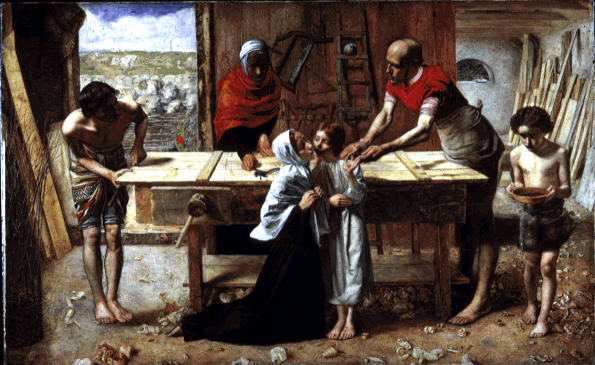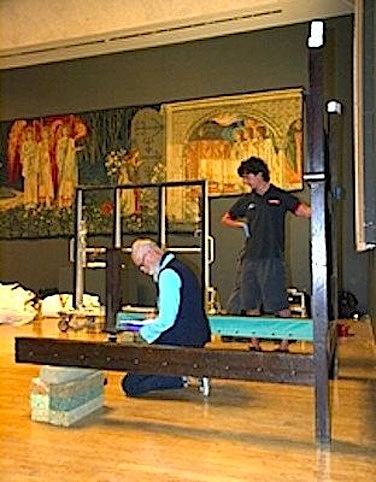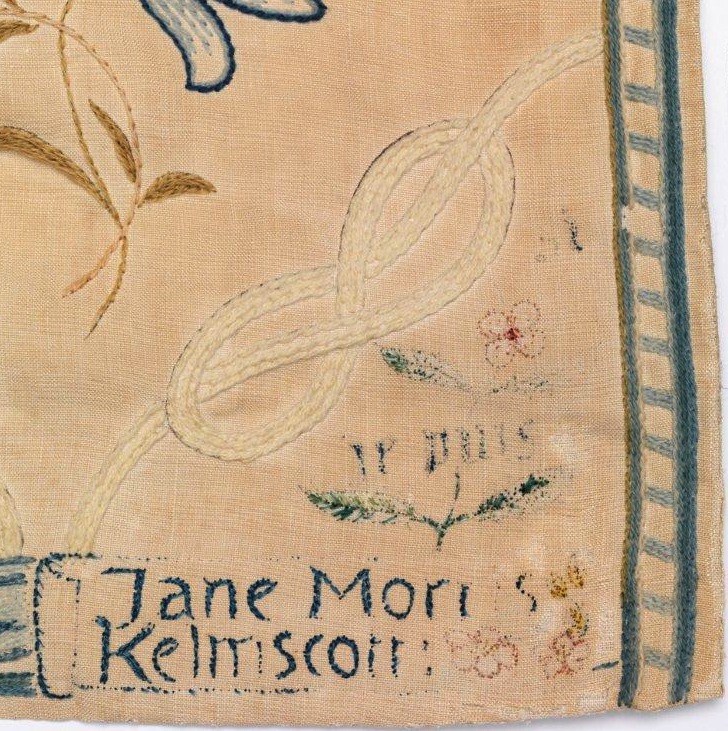This review is reproduced here by kind permission of the Historians of British Art, who first published it in their Winter 2012/13 Newsletter, pp.29-31. The original text has been adapted, reformatted and illustrated for the Victorian Web by Jacqueline Banerjee, who has also added captions and links. Click on the images for larger pictures and more information where available.

The great revival of public interest in the Pre-Raphaelites is demonstrated by the increasing number of exhibitions and books devoted wholly or partially to the Brotherhood in a wide sense, that is including their friends and "disciples" — however repugnant this latter notion may have been to the young idealists of 1848 who launched the movement. See for instance The New Painting of the 1860s: Between the Pre-Raphaelites and the Aesthetic Movement [review] by Allen Staley; John Brett: Pre-Raphaelite Landscape Painter by Christiana Payne; The Last Pre-Raphaelite: Edward Burne-Jones and the Victorian Imagination by Fiona MacCarthy and The Kelmscott Chaucer: A Census by William S. Peterson & Sylvia Holton Peterson. In the fall of 2012, the Tate organized a magnificently comprehensive exhibition, entitled "Pre-Raphaelites — Victorian Avante-Garde," which travelled to Washington, Moscow and Tokyo, all three venues giving a foretaste of the Exhibition in Puerto Rico in February 2012. These featured many scarce pieces not often seen in London, borrowed from American museums and private collections — and, as is now the established practice, it gave birth to an equally comprehensive catalogue, with full-color large-size high quality photographs of the exhibits. Each benefits from an extensive commentary by one of the three co-authors and co-curators of the exhibition (Alison Smith, Lead Curator, Nineteenth-Century British Art, Tate London; Tim Barringer, Paul Mellon Professor of the History of Art, Yale University; and Jason Rosenfeld, Distinguished Chair and Professor of Art History at Marymount Manhattan College, New York). Some notices on works by Burne-Jones and William Morris are signed "DW" — i.e. Diane Waggoner, Assistant Curator in the Department of Photographs, National Gallery of Art, Washington. The discussion of individual works is preceded by two short introductory chapters, "Victorian Avant-Garde" by Tim Barringer and Jason Rosenfeld; and "Medium and Method in Pre-Raphaelite Painting" by Alison Smith. Additionally, there is a final chapter on "The Pre-Raphaelite Legacy" by Elizabeth Prettejohn, Professor of the History of Art at the University of York.


Two paintings in the original Tate exhibition. Left: William Holman Hunt's The Awakening Conscience (1853) in Room 3, with its "aspects of gender, sexuality and desire." Right: Sir John Everett Millais's Christ in the House of His Parents (1849-50) in Room 4, bringing up questions about "the relationship of current art-making to the art of the past."
The "Victorian Avant-Garde" chapter is important at least for two totally different passages. The first gives a very useful up-to-date list of the exhibitions mounted and books / catalogues published on the Pre-Raphaelites (the details are of course given in the "Select Bibliography" at the end of the book) since the last major exhibition on the subject at the Tate in 1984. The second is a long sentence which deserves to be quoted in full here because it excellently sums up the point which the three authors / curators want to make:
The emphasis on complex and unresolved narrative, on social commentary, on aspects of gender, sexuality and desire, and on race, empire and travel; the dialogue with photography and mechanical image-making; the questioning of conventional values, accepted concepts and canons of beauty; the relationship of current art-making to the art of the past; and issues of appropriation and synthesis: all these are preoccupations in the art and culture of our own turbulent times that were vividly explored by the Pre-Raphaelites, the Victorian avant-garde, at the moment of the inception of modern society. [17]




Left to right: (a) and (b) The installation of the Morris four-poster bed at the Tate for the exhibition, under the supervision of Nigel Bamforth (kneeling), senior conservator at the Victoria & Albert Museum. Courtesy of Crown Fine Art and Simon Harvey William. (c) and (d) Details from the bedspread, © The Society of Antiquaries of London. The furthest right shows Morris's motto, "Si Je Puis" (seen also, e.g., on the tiling at Red House), with Jane Morris's embroidered signature, and the place, Kelmscott.
The exhibition offered some 180 objects, and the catalogue perfectly reflects this, with 175 reproductions of the exhibits and 31 complementary and explanatory figures. Most of the paintings will be familiar to readers — but one never tires of reading the excellent, copious commentaries provided here — especially when the "narrative" is based on forgotten poems or complex mythological stories. William Morris devotees will have seen his fine books before, but few will have actually seen the famous four-poster bed so often shown in books on him. The bed, from Kelmscott Manor in Gloucestershire, was loaned for the first time — and apparently it crossed the Atlantic, too. The detailed commentary by Alison Smith on the pelmet and bedspread designed by his daughter May and executed by her mother Jane and herself should be read in advance by all those who intend to visit the exhibition. The same holds good for her masterly description and discussion of the superb "The Prioress's Tale" Wardrobe, designed by Philip Webb and decorated by Burne-Jones after a story in Chaucer's The Canterbury Tales, bequeathed by May Morris to the Ashmolean Museum, Oxford, which loaned it.

"The Prioress's Tale" Wardrobe, © Ashmolean Museum, Oxford. Click on the picture for full details of its provenance.
Many readers will be intrigued by the thesis defended by Elizabeth Prettejohn — that "the Pre-Raphaelites have never been out of the public eye" (231). In fact, this chapter complements the "Envoi" which she wrote for the collection which she recently published, The Cambridge Companion to the Pre-Raphaelites. Whatever the merits of her case, we can all agree with Tim Barringer and Jason Rosenfeld when they write that "[e]ach generation has reinvented the Pre-Raphaelites in its own image" (16), and the book will no doubt give boundless enjoyment to twenty-first century readers if read in this light. It goes without saying that all Art School and University Libraries should have a copy.
Bibliography
Barringer, Tim, Jason Rosenfeld and Alison Smith, with Contributions by Elizabeth Prettejohn and Diane Waggoner. Pre-Raphaelites: Victorian Avant-Garde. London: Tate Publishing, 2012. 256 pp. Pbk. £24.99. ISBN 978-1849760157. Cloth: £35. ISBN 978-1854379306.
Last modified 6 March 2014